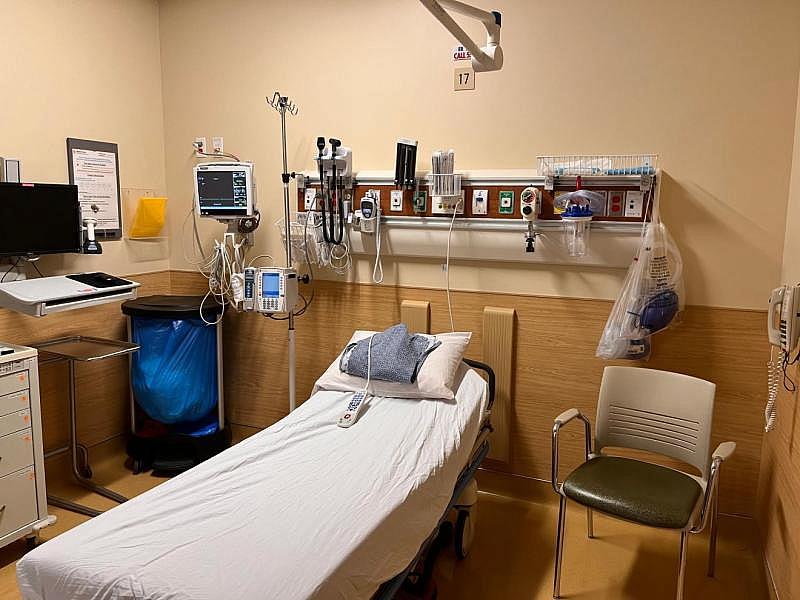Santa Barbara County Underutilizing Its Highly Anticipated Crisis Stabilization Unit
This article was produced as a project for the USC Annenberg Center for Health Journalism's 2021 Data Fellowship. It is the third in a series investigating the shortage of acute care psychiatric beds for people experiencing a mental health crisis in Santa Barbara County.
Other stories in this series include:
Part 1: Santa Barbara County’s Shortage of Psychiatric Acute Care Beds Leads to Long Waits, ER Holds
Part 2: Santa Barbara County Pays Millions to Send Local Mental Health Patients to Faraway Hospitals
Part 4: County Shares Programs, Expansion Plans for Mental Health Care After Noozhawk Series

Dr. David Ketelaar, an emergency medicine physician at Marian Regional Medical Center in Santa Maria, hosts a tour of the new Crisis Stabilization Unit that the hospital is establishing.
(Marian Regional Medical Center photo)
When the Santa Barbara County Department of Behavioral Wellness opened its Crisis Stabilization Unit in 2016, the goal was to intervene with mental health clients at an earlier stage in order to prevent them from getting to a crisis stage where they may need to be hospitalized.
“Our goal is — we are an urgent-care psychiatric, so we try to keep people out of the hospitals and off of 5150s,” LaTasha Al-Jarboua, a physician assistant, said at the time of the unit’s opening.
In 2014, Santa Barbara County received two grants totaling $2.7 million from the California Health Facilities Financing Authority with the task of creating two facilities and a program expansion for people in a mental health crisis.
Roughly 55% of the grant funding — $1.5 million — would go toward opening and operating the Crisis Stabilization Unit, according to records obtained by Noozhawk.
The unit, at 305 Camino Del Remedio in Santa Barbara, provides a maximum of 23 hours of mental health care for residents older than age 18 and can serve eight to 12 patients at a time.
It is a voluntary facility that has the goal of providing patients a less-restrictive level of care and adequate time to stabilize so they do not get to the crisis stage where they may need more restrictive hospitalization.
When the unit first opened in 2016, only 22% of its clients were sent from one of three county hospitals, according to the records.
“When our CSU first opened, it was the first CSU in the county, so while (the Department of Behavioral Wellness) knew what it was, it took a bit longer for the community to know how to utilize it,” Suzanne Grimmesey, spokeswoman for the Behavioral Wellness Department, told Noozhawk.
Marian Regional Medical Center's emergency department uses one of its rooms for involuntary psychiatric patients. (Jade Martinez-Pogue / Noozhawk photo)
In 2021, however, 63% of the Crisis Stabilization Unit patients admitted that year were sent from county hospitals.
While the intent behind the unit is a positive one, and it did provide another level of mental health service in the county, it’s no secret it has been underutilized.
Between its opening in 2016 and 2021, the unit has averaged only 1.3 people per day.
The highest year of utilization was in 2017 with 563 patients admitted, still only averaging 1.5 people per day for that year.
“We have struggled with our census at the CSU — it’s not a secret that it’s not as full as we would like it to be,” said John Winckler, division chief of clinical operations at the Behavioral Wellness Department.
If the goal was keeping patients out of hospital emergency departments and off of 5150 holds, the Crisis Stabilization Unit falls short on that end as well.
The number of patients on 5150 holds at Santa Barbara Cottage Hospital increased by 35% from 2018 to 2021, and the number of patients on 5150 holds at Lompoc Valley Medical Center increased by 16%, according to data obtained by Noozhawk.
Dr. David Ketelaar, an emergency medicine physician at Marian Regional Medical Center in Santa Maria, said the county unit has had no significant impact on the hospital’s emergency department.
“It has made absolutely no impact on the holding here in our hospital,” he told Noozhawk.
Some mental health experts say that the reason for the Crisis Stabilization Unit’s shortcoming is simply the way it was designed.
Dr. David Ketelaar, an emergency medicine physician at Marian Regional Medical Center, says that "75% of the people placed on 5150s (psychiatric holds) don't need to be here, the crisis can be abated and dealt with in 24 hours."
The unit is an unlocked — or voluntary — facility, meaning that patients can come and go as they wish without being medically cleared by a physician before leaving.
A 5150 hold by definition is involuntary; someone from the county’s mobile crisis team or a contracted psychiatrist at Santa Barbara Cottage Hospital must write the hold. Those on a 5150 hold cannot be released to the unit until after the hold is over, and they have to want to go to the unit themselves.
“Locked and unlocked is a licensing issue,” Winckler explained. “If a facility is locked, it means that the person doesn’t have the right to leave.
“The CSU is not locked, so if an individual wants to leave, they can get up and walk out.”
While some larger counties have a county general hospital, Santa Barbara County does not, so the only option for people on 5150 holds waiting for an inpatient bed is the emergency room department, Grimmesey said.
“The CSU has to have the designation of a locked facility that can house not just voluntary patients, but involuntary,” George Kaufmann, former president of the Santa Barbara County chapter of the National Alliance on Mental Illness, told Noozhawk.
“Because of the way they chose to operate it and structure it, it’s been absolutely useless. It can’t be effective unless it serves voluntary and involuntary.”
Of the patients admitted to the Crisis Stabilization Unit between 2016 and 2021, an average of 45% self-discharged.
“What law enforcement soon found out was that if they brought someone to the CSU, very often they would get a call 15 minutes later that the person walked away and was causing problems somewhere else,” Kaufmann said.
“Everybody but the department has long since given up on the CSU, and it’s such a shame because the need is so great, and it’s a good idea, but it was flawed in the way that the grant was written to operate it.”
The number of patients admitted into the county’s Crisis Stabilization Unit has been steadily decreasing since 2017, dropping to 272 admissions in 2021 from 563 in 2017.
However, the unit was intermittently closed throughout 2021 due to staffing shortages at the county Psychiatric Health Facility next door, according to Laura Zeitz, the PHF’s administrator.
If Psychiatric Health Facility staff were out sick with COVID-19, the facility would take staff from the Crisis Stabilization Unit in order to keep the PHF open, she explained.
She said the fact that the PHF was a locked facility, and that it could hold both involuntary and voluntary patients, was one of the main factors considered in that decision.
Marian Regional Medical Center is in the process of opening its own locked crisis stabilization facility just across the street from its emergency department, and Ketelaar said that having the locked unit could divert 60% to 80% of the patients who need a holding bed.
“75% of the people placed on 5150s don’t need to be here, the crisis can be abated and dealt with in 24 hours,” he said. “Because it will be a locked facility, we can keep them there until they have stabilized.
“Getting them here in a private setting, with a physician just for them, the quicker we can do that, the faster we abate the problem.”
When someone is on a 5150 hold or in a mental health crisis, the hospital can’t release them until the person has a safe disposition. Historically, those patients must wait out the crisis in the emergency department without a psychiatrist or mental health clinician to help mitigate the crisis.
“With the locked CSU, they can get that care that they need to stabilize faster than just waiting for an inpatient bed or sending them 50 miles away to the CSU in Santa Barbara,” Ketelaar said.
While the Crisis Stabilization Unit has fallen short in its goal of keeping patients out of the hospitals on 5150s and in-county, the implementation of the county’s Crisis Residential Treatment program in 2019 coincides with a reduction of out-of-county hospitalizations.
The Crisis Residential Treatment program established a noninstitutionalized program for mental health clients to receive up to 90 days of respite, peer support, and connections to ongoing services and resources.
From 2017 through August 2019, just before the Crisis Residential Treatment program began, out-of-county hospitalizations stabilized at an average of roughly 490 bed days per month, according to data obtained by Noozhawk.
After the program began, from September 2019 through December 2020, the average number of bed days for patients hospitalized out of county was roughly 360 bed days per month — a decline of more than 25%.
“We definitely have better flow from the PHF to the Crisis Residential Treatment program (as opposed to the CSU),” Zeitz said. “It provides a safe landing spot for patients to go from a very intense structured program to stepping down.”
What’s Next in the Series
This report is the third in Noozhawk’s series analyzing Santa Barbara County’s acute care beds for mental health patients in crisis.
Click here to read the first story addressing the local shortage of psychiatric treatment beds.
This series is produced as a project for the USC Annenberg Center for Health Journalism’s 2021 Data Fellowship.
Noozhawk reporters and editors plan to develop more stories on the local mental health care system, and we want to hear feedback, suggestions, and story tips from readers.
You can reach us at news@noozhawk.com.
Acknowledgements
This project would not have been possible without the help of Santa Barbara County’s mental health partners, including providers, advocates, patients and their families.
Noozhawk would like to thank Suzanne Grimmesey and the county Department of Behavioral Wellness, Dr. David Ketelaar of Marian Regional Medical Center, Cottage Health, Lynne Gibbs from the National Alliance on Mental Illness, and many others who contributed their time and experience to this reporting project.
— Noozhawk contributing writer Jade Martinez-Pogue can be reached at news@noozhawk.com. Follow Noozhawk on Twitter: @noozhawk, @NoozhawkNews and @NoozhawkBiz. Connect with Noozhawk on Facebook.
[This story was originally published by Noozhawk.]

